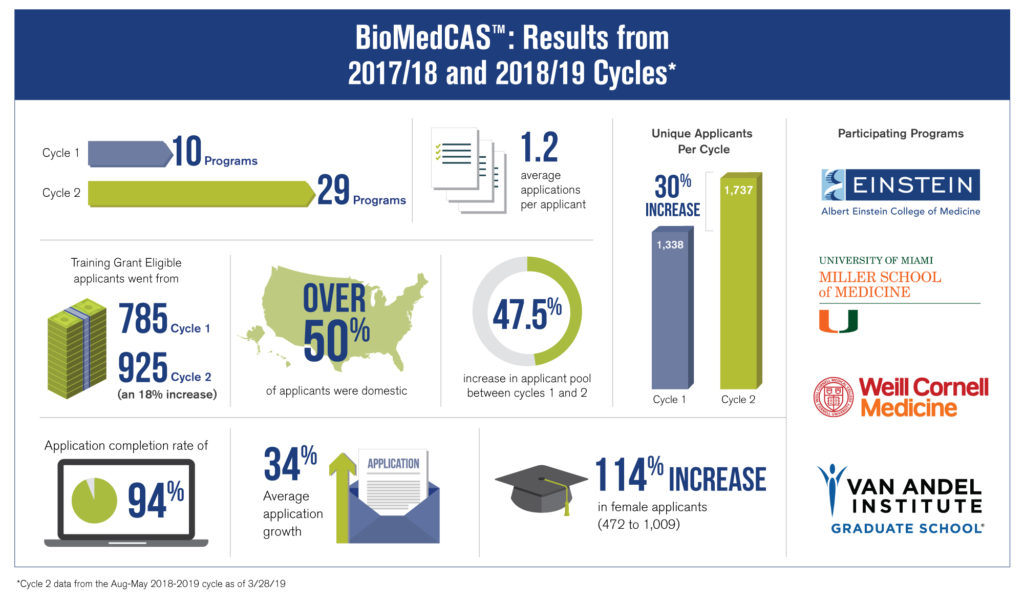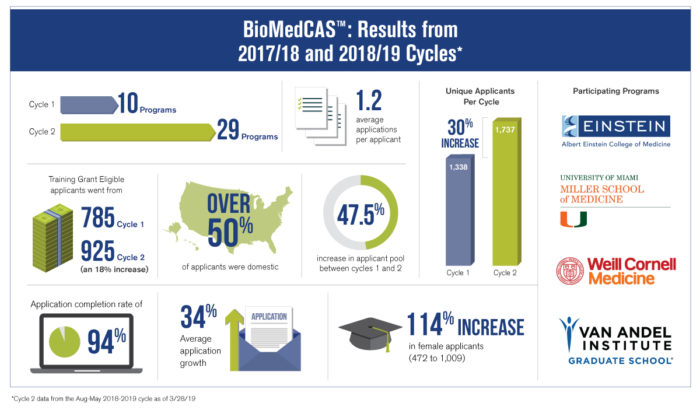
It’s an exciting time in the biomedical sciences, with the recent 2019 Pew annual meeting revealing biomedical researchers’ cutting-edge explorations of new approaches to flu, cancer and cell division. In the quest to cure disease and enhance human health, the biomedical sciences sector appears to be on the cusp of a golden age.
At the same time, the field’s progress hinges on the success of the academic programs which produce the next generation of biomedical sciences researchers — and those programs, particularly their admissions offices, are facing unprecedented pressure due to more competition for applicants.
That’s where BioMedCAS™, the first and only Centralized Application Service for biomedical sciences programs, can help. BioMedCAS offers an improved way to recruit, enroll and admit best-fit students while saving money and better allocating staff resources each admissions cycle.
Today, more than 31,000 programs on over 1,000 campuses use a CAS. Liaison has partnered with more than 30 professional associations to create over 40 discipline-specific iterations of the CAS, enabling the associations to better support their members by promoting best practices and the adoption of a transformative tool in the admissions process.
Launched in July 2017 and developed in partnership with biomedical sciences program directors, BioMedCAS is primarily geared towards PhD programs, but any BioMedCAS participant that offers an approved PhD in biomedical sciences can also accept master’s program applications through the platform.
Several factors are contributing to a diversity renaissance in the biomedical sciences and other STEM disciplines — including #GREexit, the trend of graduate programs increasingly removing the GRE and other standardized tests as a requirement for admission. This has opened the door for a more holistic standard of application review that leads to greater admission for women, African-Americans and other underrepresented demographic groups in the biomedical sciences.
On a parallel track with this shifting admissions landscape, member schools are seeing strong results from participating in the BioMedCAS community as the platform’s second admissions cycle nears its completion.
“Through the BioMedCAS program, our admissions office and faculty are both seeing time and effort savings,” said Matthew Brandon, associate director of the Office of Graduate Studies at the University of Miami Miller School of Medicine. “Now, our prospective students are met with an application that’s far more intuitive and easier to use than our prior application service. As far as processing goes, BioMedCAS eliminates a lot of the work on our side, and it makes it easier for our various committees to review their applicants.”
The number of programs participating in BioMedCAS nearly tripled by the end of the second cycle. Participating programs have seen an application completion rate of 94%, average application volume growth of 34% and an average of 1.2 applications submitted per applicant.
What’s even more significant, though, are the improved results for participating programs from cycle 1 to cycle 2. Year over year, BioMedCAS participants have seen a 47.5% increase in total applicant pools, a 30% increase in unique applicants per cycle, a 114% increase in female applicants and an 18% increase in applicants who are eligible for training grants.
Liaison projects that by transitioning from decentralized application processing to a CAS, programs will experience a 90% decrease in manual administrative tasks, a 10% increase in diversity of incoming classes and a 69% reduction in decision-making times.
While the average admissions professional might think that such game-changing results would require sweeping, time-consuming institutional change, the Miller School of Medicine’s Brandon praised the smooth experience of transitioning to a CAS.
“The setup process is very easy for administrators who just need to make their own minor customizations and set up their own local statuses [the labels given to applications at various stages of the application process], reports and lists,” he said.
Brandon added that the school can “segment our applications by programs much better than before. This helps us ensure that the faculty see information that is relevant to their specific programs. That’s been very helpful.”
